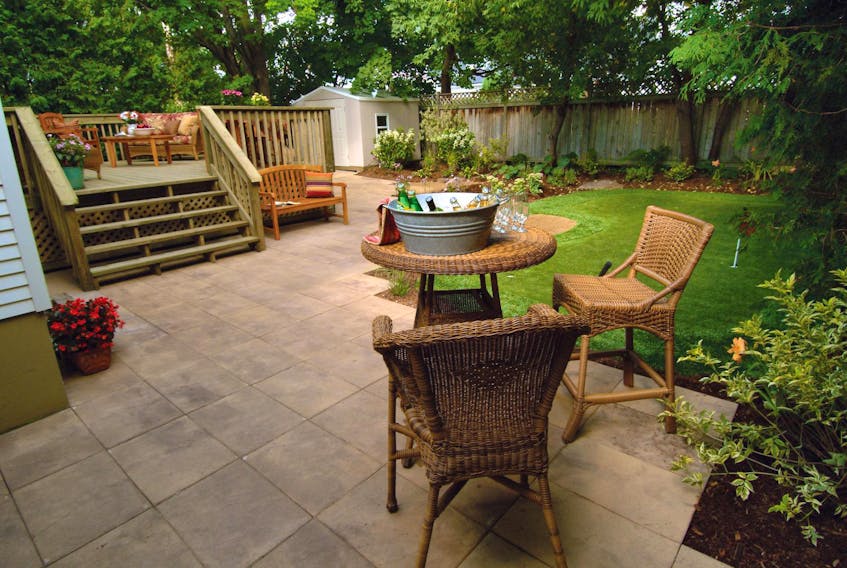In speaking to several industry professionals, the average backyard renovation starts at around $20,000 — with some projects crossing the million-dollar mark.
With such a huge range, how do you know how much your outdoor renovations should cost and how much should you really be investing in your home?
One of the biggest mistakes that a client makes is to envision what they want in the yard before they really set the budget. When I meet with a client, I start by asking about the approximate value of the home. If you set your budgets based on percentages of your total home’s worth, you know that your plans will stay aligned with property values in your neighbourhood.
Here are some things to consider:
Is your front yard a showstopper?

Front yards have been getting more attention by realtors and housing experts because of first-impression numbers. Several online sources place the value of curb appeal and a home’s first impression between five to eight per cent of the home’s worth.
Items like shade trees and front walkways contribute to higher returns, as do front porches and sitting areas. While plants and gardens are important to the overall appeal, too many flowers in the front yard intimidate buyers looking for low-maintenance homes.
For my general rule, I try to keep the front-yard landscaping at seven per cent of a homeowner’s renovation budget. That number does not include the driveway, even though it may be at the front of your home.
Is your back yard functional?

Backyards tend to be more about function than a front yard renovation. Good design can offset the shortfalls from the inside of the home with outdoor elements that meet the same need.
For example, if a home has a small kitchen, adding an outdoor version with a barbecue or a smoker is a smart investment because it partially addresses buyers’ concern when they see the inside space.
Having a good deck or patio in your backyard that provides lots of living space can increase your home’s value by up to 12 per cent (Century21, Canada).
Consider your return-on-investment
According to several online reports — including Remodeling Magazine’s 2019 Cost vs. Value Report — a major kitchen renovation has an expected return of 62.1 per cent if you sell the home within five years of the completion of the work. After five years, that number steadily drops as styles change. A simple wood deck has an expected return of 79 per cent for the life of the deck, which averages eight to 10 years in Canada.
These numbers are important if you are planning to hire a contractor to do the work. By using these percentages of increased value, you now have a guideline for reasonable investments in your home. For example, if your home is worth $300,000, you can comfortably spend $15,000 on a front-yard renovation because your investment is secured by the increased value to your home.
Know your “why”

Even if you are planning to do some or all of the work yourself, there are several things you should consider before you run out to the box store to stock up on supplies.
First, ask yourself “What is the real purpose of this space?” Do you a reason for investing in your outdoors? Some homeowners need extra living space, others may need a spot for summer dining. Knowing the purpose will help you design and understand the square footage that you require.
For example, you may want a patio table, an area for conversation separate to the table for guests, a spot for a comfortable lounger and maybe a spot to read. Each of these requests requires a footprint (occupied space). For example, a four-person table needs a 10x10 area so that all of the guests can sit comfortably and still have some room around the back of their chairs.
Identify obstructions
What obstructions are you working around? Too often, homeowners want a deck without realizing that their doors are ground-level or that they have windows to the basement that would get blocked by a wooden structure.
A deck requires a sub-structure which is at least 8-12” high, and that’s before you install the floorboards on it. I think some people believe decking can be installed like a floating floor in the kitchen. To get a deck to be flush to the ground, the entire substructure has to be dug out. It’s possible, but can be extremely labour intensive.
Know the codes

Finally, you have to plan for stairs and railings. Too many DIYers build home decks without proper access. What might start as a low deck can quickly get taller in areas where the ground is not level.
While building codes differ by region, usually any deck above the height of 24” requires a railing. This 24” measurement is from the longest point between the ground and the top of the deck surface.
The optimal height for a stair riser is 7”, so when you are measuring the distance from the ground to the top of the completed deck, try and plan for a number that is divisible by seven so that you will have stairs of equal height.
As you plan your spring projects this year, budget your dollars accordingly. Whether you want to do the work yourself, or are planning on hiring a reputable company, I always tell homeowners to set aside about 20 per cent of their renovation budget for the outdoors.
This may seem like a lot, but with all of the housing market numbers showing big returns in landscaping, you can renovate knowing that you money is being spent wisely.









